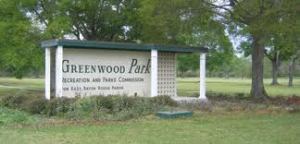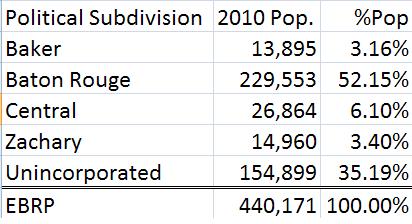Let’s get the initial and obvious comment out of the way… barring medical emergencies, 2 out of 3 Louisiana voters suck. While the Secretary of State’s office has not yet released Parish by Parish turnout statistics, the estimate for statewide turnout is somewhere around 36%. Seriously? With around 8 days offered to vote (including early voting and excluding mail-in voting), only 1 in 3 people (plus the second guy’s foot) bothered to cast a ballot. That’s pathetic. Look, I wasn’t all that excited by most of the statewide races offered to me. In most cases, it was the cliched situation of choosing a lesser of two evils. Still, I held my nose and voted because I think it’s important. Regardless of the statewide races, there were a number of interesting local races as well as 5 Constitutional amendments that were Yes or No decisions. While I held out hope that turnout was better in East Baton Rouge Parish (EBRP) with local favorite Jay Dardene running in a competitive election, it looks like the race with the highest level of participation in EBRP was for the Governor, with about 32% of registered voters casting ballots (and surprisingly with hometown hero Bobby Jindal only pulling about 50% of the vote). Voting on local propositions was around 28% to 29%. On to the results…
Other analysts are welcome to pour over the local candidate elections, but the underlying rationale for some of the votes for those tend to involve an incredible amount of personal relationship minutiae, in some cases requiring one to know which candidates are being spurned by which business owners and/or pastors. I do this as a hobby, so getting up to date on all of that is not really worth it to me at this point. That’s why I’m focusing on the three parishwide propositions put forth to EBRP voters.
The proposition concerning doubling the homestead exemption for disabled vets passed in a landslide with 72% of the vote in EBRP. In fact, there were no precincts in EBRP in which it failed, although it came close in Southdowns (1-42A & 1-42B), College Town (1-69A & 1-69B), and portions of the Garden District adjacent to City Park (1-8 and 1-41A). That leaves us with the proposition elections for the Library Board of Control (LBC) and the Recreation and Parks Commission (BREC). While both propositions failed at the polls, the margin of victory was far smaller; the BREC proposition going down 48-52 and the LBC proposition failing 46-54. Because these propositions involved giving the three small cities of Baker, Zachary, and Central (BZC) in EBRP a greater voice than their populations warrant, it’s interesting to note who voted for and who voted against the propositions. Some of the results were expected, others less so.
-
“Split” Tickets: Unsurprisingly, if a precinct was in favor of one proposition, they were likely in favor of the other. Only 7% of the precincts (21 precincts) featured a “split” ticket, with one of the propositions being approved and the other failing. Of those 21 precincts, 4 voted against the BREC proposition and in favor of the LBC proposition; the remaining 17 voting in favor of the BREC proposition and against the LBC proposition. In most of these “split” ticket precincts, the margins of victory for either proposition were rather thin, regardless of whether the precinct had 500 registered voters or 1,000.
-
The Extremes: Somewhat surprisingly, the precinct that was most in favor (based on the margin of victory as a percentage of total ballots cast) of the BREC proposition was also most in favor of the LBC proposition. More surprisingly, on the other end of the spectrum, two districts swapped the #1 and #2 positions for being most opposed to the propositions, depending on the proposition in question. Why were these surprises? The precinct most in favor of the two propositions is not even in the BZC. It’s Precinct 1-95A, an overwhelmingly Democratic, overwhelmingly black area in incorporated Baton Rouge just north of Southern University. On the other end? The two precincts swapping places are almost polar opposites with respect to race and somewhat different with respect to party affiliation. Precinct 1-3 (#1 against the BREC proposition, #2 against the LBC proposition) is an overwhelmingly Democratic, overwhelmingly black area comprising portions of Old South Baton Rouge and Beauregard Town. Precinct 1-8 (#1 against to the LBC proposition, #2 against the BREC proposition) is an overwhelmingly white, politically balanced area of the Garden District adjacent to City Park. It’s interesting that two precincts that are so similar with respect to demographics and political affiliation ended up on opposite ends of the spectrum (1-95A & 1-3) and at the same time see two precincts that are quite different with respect to demographics end up being so closely aligned in their opposition (1-3 & 1-8). Then again, considering this election was set-up as a north EBRP vs. south EBRP battle, perhaps not so surprising.
- BREC v. LBC Turnout: In may seem surprising that the BREC proposition generated slightly more activity than the LBC proposition (77,532 vs 76,427 ballots cast), but it’s really a matter of perspective. While the LBC has had to deal with negative media coverage related to the River Center Library rebuild, it wasn’t an issue in any particular candidate race. BREC on the other hand, was featured as a campaign issue for several candidates seeking office in parts of the BZC, particularly with regard to breaking away from the Parish (even though I previously showed arguments concerning the northern part of EBRP not getting their fair share are pretty ridiculous). Given the “double exposure” of BREC in both candidate and proposition elections, it may be unsurprising that the proposition featured the higher turnout of the two.
- FOR the BREC Proposition: Crestworth (54.74%, 1-95B), Crestworth (44.21%, 1-95A), Scotlandville Middle (38.93%, 2-22A), Ryan Airport/Scotlandville Area (35.80%, 1-91A), Southern University (33.33%, 1-100A)
- AGAINST the BREC Proposition: Beauregard Town/Old South Baton Rouge (41.46%, 1-3), City Park/Garden District (41.01%, 1-8), Southdowns East/Pollard Estates (40.06%, 1-56B), Garden District/Mid-City (36.11%, 1-7), Tara (35.02%, 1-74B), Belfair (34.93%, 1-14A), Istrouma/Winbourne (34.63%, 1-29), Roselawn/Gus Young (33.74%, 1-32B), Old Hammond/Drusilla/Jefferson (33.33%, 3-31B), College Town (33.33%, 1-69A), Capitol/Fuqua (33.33%, 1-10A)
- FOR the LBC Proposition: Crestworth (53.85%, 1-95B), Scotlandville Middle (44.72%, 2-22A), Crestworth (38.55%, 1-95A), Ryan Airport/Scotlandville Area (38.64%, 1-91A)
- AGAINST the LBC Proposition: City Park/Garden District (44.04%, 1-8), Beauregard Town/Old South Baton Rouge (42.86%, 1-3), Capitol/Fuqua (40.63%, 1-10A), Garden District/Mid-City (39.62%, 1-7), Old Hammond/Drusilla/Jefferson (38.65%, 3-31B), Belfair (38.38%, 1-14A), College Town (38.14%, 1-69A), Garden District/Hundred Oaks (37.30%, 1-48B), Staring/Pennington (37.14%, 1-66B) Old South BR/Nicholson (37.14%, 1-5A), Southdowns East/Pollard Estates (36.91%, 1-56B), Southdowns/LSU Lakes (36.25%, 1-41A), Seigen/Perkins East (35.76%, 3-4A), Winbourne/Ardenwood (34.85%, 1-62), Tara (33.57%, 1-74B)
-Politivore









